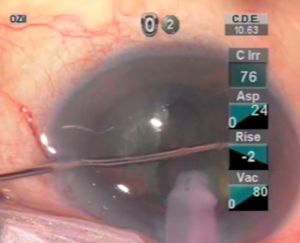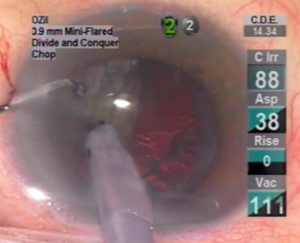Zero-Min-Spin Technique
All content on Eyewiki is protected by copyright law and the Terms of Service. This content may not be reproduced, copied, or put into any artificial intelligence program, including large language and generative AI models, without permission from the Academy.
Zero-Min-Spin Technique in Cataract Extraction[1]
Zero-Min-Spin Technique
Traditional teaching of cataract extraction with phacoemulsification emphasizes the value of turning the nucleus for techniques such as divide and conquer and chopping. The Zero to Minimal Spinning (Zero-Min-Spin) technique in this article highlights an extraction methodology which requires zero to minimal rotation of lens material and can be adapted to various chopping techniques.
Advantages of this technique relate to less iatrogenic zonular stress during lens extraction by phacoemulsification. This is especially relevant in cases with zonulopathy of various etiologies. Less zonular stress may also be beneficial when considering intraocular lens technologies such as accommodating, multifocal and toric lenses where symmetry of the capsular-zonular system may be critical to best function and long term viability.[2][3]
Pre-Operative Considerations
A blunt second hand chopper is best utilized for mild to moderate density nuclear sclerosis, whereas a sharper tipped chopper is beneficial when dealing with higher density nuclear sclerosis.
Ideally the keratome wound and paracentesis should be sufficiently spaced apart to allow for appropriate vector force application.
- Wounds that are too close together lead to torque during the first chop.
- At least 45 degrees of spacing is recommended.
Technique
- After completion of the capsulorrhexis and hydrodissection, a central groove is sculpted and a hemi-nuclear division is created with a two handed technique.
- Using the phaco hand-piece as a stabilizing force within the groove, the second hand instrument is accurately placed distally over the nucleus and under the anterior capsule.
- The instrument is then brought in a slight downward Z direction and toward the phaco hand-piece creating 2 quadrants. (See Figure 1)
- To avoid the need to spin the lens material, the second hand instrument is used to manually extract each of these quadrants to the safer supra-capsular space for emulsification.
- Specific attention must be paid to keeping the second hand instrument under the anterior capsule when extracting pieces, otherwise inadvertent capsular-zonular damage will occur.
- After removal of the first hemi-nucleus with phacoemulsification, the remaining hemi-nucleus already aligned for good access is drawn centrally engaging the phaco tip with slight pronation for better purchase.
- The distal 30-40% of the hemi-nuclear segment is then horizontally chopped. (See Figure 2)
- This process is repeated as needed to remove the remaining nuclear fragment with minimal need for rotation.
Conclusions
The Zero-Min-Spin technique allows for safe, efficient lens disassembly and extraction during cataract surgery by phacoemulsification for moderate to dense lenses. This technique can be adopted at all levels of experience of cataract surgeons including residents and fellows in training.
References
- ↑ Nguyen, M, Lin, A, Jung, H. Zero-Min-Spin by Drs. Nguyen, Lin and Jung. Youtube. https://youtu.be/1lsbce_Qd10. Accessed August 19, 2018.
- ↑ Chang D. Phacoemulsification in High-Risk Cases. In Refractive Cataract Surgery and Multifocal IOLs. Thorofare, NJ: Slack Inc., 2000:123–136.
- ↑ Hasanee K, Butler M, Ahmed K. Capsular Tension Rings and Related Devices: Current Concepts. Curr Opin Ophthalmol. 2006;17(1):31–41.



